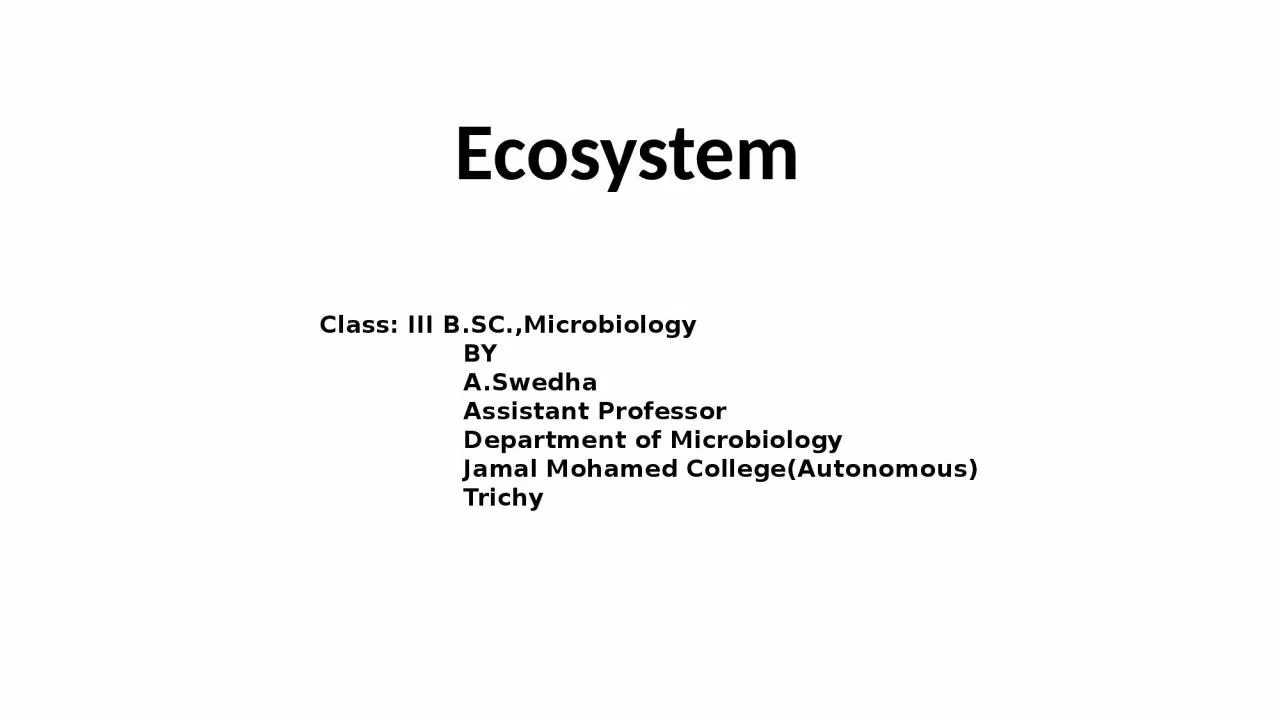

BY ASwedha Assistant Professor Department of Microbiology Jamal Mohamed CollegeAutonomous Trichy Ecosystem What Is An Ecosystem An ecosystem forms the basic building block of an environment ID: 1027034
Download Presentation The PPT/PDF document "Class: III B.SC.,Microbiology" is the property of its rightful owner. Permission is granted to download and print the materials on this web site for personal, non-commercial use only, and to display it on your personal computer provided you do not modify the materials and that you retain all copyright notices contained in the materials. By downloading content from our website, you accept the terms of this agreement.
1. Class: III B.SC.,Microbiology BY A.Swedha Assistant Professor Department of Microbiology Jamal Mohamed College(Autonomous) TrichyEcosystem
2. What Is An Ecosystem? An ecosystem forms the basic building block of an environment. It consists of both biotic and abiotic components and their continuous interactions with each other. Ecosystems can broadly be classified into two types, namely: Natural ecosystem – naturally occurring Artificial ecosystem – These are man-made ecosystems Natural Ecosystem A natural ecosystem is a community of living and non-living entities and occurs freely in nature. Every component interacts together as a combined unit through physical, chemical and biological processes. The discriminating factor of natural ecosystems from other ecosystems is that they are completely natural.
3. Their interactions in no way are influenced by human activity as seen in the case of artificial ecosystems. The components of natural ecosystems that bring about these interactions are soil, sunlight, air, water, plants, animals and microorganisms. Each of these factors of the ecosystem is associated either directly or indirectly. For example, a fluctuation in the temperature levels affects the growth of plants.Examples Of Natural Ecosystems Deserts, virgin rain forests, the abysmal plain are a few examples of naturally occurring ecosystems. They are majorly devoid of human existence, thereby enabling these sites to continue existing in their natural state. However, these ecosystems, with time undergo changes in the event of environmental changes regardless of human existence.
4. Types Of Ecosystems The size of every ecosystem varies. On earth, ecosystems are interlinked to make biome – land or atmosphere, the area of sea, forests, reefs etc.Depending upon the habitats, biomes are connected with each other which possess several ecosystems. There are two main types of natural ecosystems: Terrestrial ecosystem: Land-based Aquatic ecosystem: Water-based There are various other types of ecosystems. Listed below are the types of ecosystems which are categorized into either terrestrial or aquatic ecosystemsDesert Ecosystem : The desert ecosystem can be seen existing in the artics as well as the tropics. As presumed, not all of the deserts are hot. Some are usually windy. The most striking feature of this ecosystem is the amount of precipitation it receives, which is the least as compared to any other ecosystem. A few deserts are comprised of rocks while some have sand dunes. Flora is very rare, but highly adaptive animal species and insects are found here
5. Forest Ecosystem The forest ecosystem is classified on the basis of the climate which can either be tropical, temperate or boreal. In temperate zones, the forest ecosystem can have a deciduous, coniferous type or a combination of both types of flora. The tropics have rainforest ecosystems which include the most diverse animal and plant ecosystem in comparison to any region on the planet. In this region, trees are found growing tall, with denser foliage and humid environment wherein species are found right from the roots up till the canopy. Marine Ecosystem The marine ecosystem refers to the aquatic ecosystem containing saltwater and harbours a range of species. This ecosystem is the vastest and the biggest ecosystem on earth. They not only embed the oceanic beds, but also the salt marshes, tidal zones, saltwater swamps, mangroves, coral reefs etc.
6. Freshwater Ecosystems The freshwater ecosystem refers to the aquatic ecosystem containing consumable water, as opposed to marine ecosystems, they concern with the ecosystem found in the lakes, ponds, rivers, springs, freshwater swamps that have fresh water. They nurture planktons, algae, insects, amphibians and underwater plants. Tundra Ecosystem Tundra symbolises polar regions at relatively lower altitudes. It is identified by harsh environmental conditions correlated to deserts and is habitually treeless, windswept and snow-covered. The soil is found frozen all through the year and throughout the fleeting summers, snow melts to produce shallow ponds, thereby giving rise to lichens and small flowers. Grassland Ecosystem The grassland ecosystems are found in steppes, savannas, and prairies, in the tropical and temperate regions. They can be found in colder regions and have a prevalent feature: semi-aridity. The trees in these regions are close to non-existence and flowers may be distributed along with the grass. These ecosystems are typical for animal-grazing